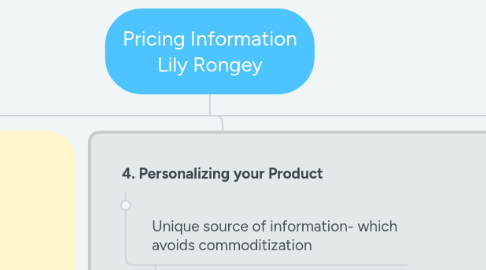
1. 1. Cost of Information
1.1. First-Copy Cost Definition
1.2. "Information goods is that their cost of production is dominated by first-copy costs... first copy of a book has been printed, the cost of printing another one day is only a few dollars" (p.20).
1.2.1. Fixed Costs
1.2.1.1. Production are large
1.2.1.1.1. Variable Costs of reproduction are small
1.2.1.1.2. Sunk Cost
2. 2. Cost and Competition
2.1. Information is costly to product but cheap to reproduce
2.1.1. Multiple Copies can be produced at roughly constant per-unit cost
2.1.1.1. Competitive Pricing Strategy
2.1.1.1.1. Business Plans = "Information Auctions"
3. 4. Personalizing your Product
3.1. Unique source of information- which avoids commoditization
3.1.1. Terms of pricing and product design: How do you package and present your information?
3.1.2. 1. Personalize or customize
3.1.2.1. your product to generate the most value of your customers
3.1.2.2. 2. Establish pricing arrangements
3.1.2.2.1. that capture as much of that value as possible
3.1.2.2.2. Good example of how information technology can be used to personalize information services
4. 6. Pricing your product
4.1. Internet makes it easy to personalize your price.
4.1.1. Pigou created a three-step category
4.1.1.1. 1. Personalized Pricing
4.1.1.1.1. Sell to each users at a different place
5. 5. Know your Customer
5.1. a. Registration and Billing
5.1.1. Asks for demographic information
5.1.2. Example: Zip codes information is an automatic requirement for mail-based subscriptions
5.1.2.1. Joke: About the two dogs, at the computer, where one says to the other, On the internet no one knows you’re a dog
5.1.2.1.1. b. Observation
6. 3. Market Structure for Information goods
6.1. High sunk costs, low marginal cost feature of information markets is important for those in industries
6.1.1. Two sustainable structures
6.2. a. Dominant Fim
6.2.1. May or may not produce the "best" product
6.2.1.1. But by size and scale, economies enjoy a cost advantage over its smaller rivals
6.2.1.1.1. example; Microsoft- controls the market for operating system of desktop computers
6.2.1.1.2. b. Differentiated product
7. 7. Group Pricing
7.1. Price Sensitivity
7.1.1. If members of different groups systemtaically differ in their price senstitivty, you can profitably offer them different prices.
7.1.2. Student discounts and senior citizens are popular forms of group pricing
7.1.3. Lock-in
7.1.3.1. If an organization chooses to standarize ona particilar product it may be very expensive for it to make the swtich owing the cost of coordination and retaining
7.1.3.2. Phrase: "Get' em while they young" Student discounts are attractive because students are very sensitive to price
7.1.3.2.1. Selling a good that has big switching costs, then it pays you to offer deep discounts to get the consumers "addicted" to your product
